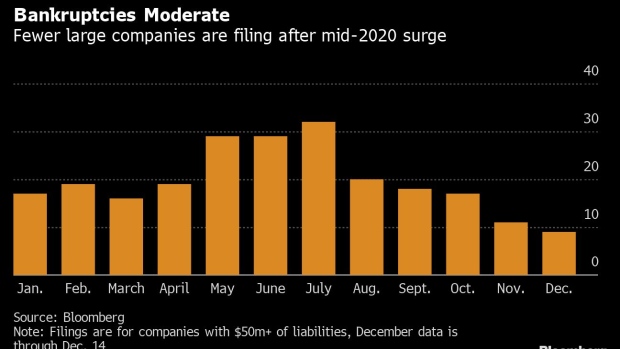Dec 16, 2020
Distressed Investing’s ‘Wall of Money’ Eyes 2021 Opportunities
, Bloomberg News

(Bloomberg) -- Restructuring specialists say they’re not done fixing the balance sheets of companies hit hard by the Covid-19 pandemic, even after a wave of large corporate bankruptcies in 2020.
Promising vaccines may not reach the general public fast enough to save a number of struggling companies next year, and workout professionals and distressed investors are expecting smaller private companies will search for cash in 2021. They’re also anticipating that businesses of all sizes may struggle to adjust to changing consumer habits in a post-pandemic world.
“We’re going to have the long-tail impact of Covid in various industries,” Roopesh Shah, a senior managing director at advisory firm Evercore Inc., said in an interview.
Few predict a repeat of this year’s pain, which saw the universe of distressed bonds and loans approach $1 trillion in March, but the potential for a new stream of troubled companies underscores the depth of the wounds the pandemic inflicted on businesses and the limits of the Federal Reserve’s extraordinary support for the credit markets.
Shah said many firms that got short-term liquidity in the depths of the crisis will need to find longer-term financing sources as 2020’s deals mature. He’s also expecting smaller sponsor-backed companies with high debt loads and dwindling revenues to be a focus for restructuring professionals and investors.
Although the new year is expected to bring fewer bankruptcies after the long-troubled oil and gas and retail industries saw the weakest borrowers file for Chapter 11, there will still be opportunities to provide rescue financing to those industries, along with leisure and hospitality firms, according to Bruce Richards, chief executive officer of the nearly $20 billion credit investor Marathon Asset Management.
“2021 is going to be a big year for capital solutions,” he said. “There’s a wall of money and tremendous technical support for the high-yield market.”
Thanks to support from the Federal Reserve and U.S. Treasury, high-yield and distressed debt came roaring back in the second half of 2020 after the first part of the year’s pandemic-spurred shutdowns, market panic, mega bankruptcies and negative oil. Even the riskiest part of the junk market -- bonds rated CCC -- is poised for a positive annual return after recovering from March’s plunge.
Ripping Markets
Likewise, the pace of bankruptcies has slowed from mid-2020’s peak. The volume of debt trading at distressed levels has dropped to $184 billion, and high-yield bond risk premiums have fallen to 3.79% from 11% in March. Spreads on CCC bonds now sit below 7%.
“The markets came ripping back, and they haven’t stopped ripping since,” Richards said.
Investors with knowledge of credit agreements and capital structures have had a lucrative second half of 2020, provided they had cash to put to work in the depths of the crisis, according to Ryan Mollett, global head of distressed debt and special situations at Angelo Gordon & Co.
As the market has rallied, the $41 billion investment firm has been selling out of some positions in favor of opportunities in longer-term private financing deals, Mollett said.
“We’re focused on rescue capital solutions for companies that don’t have access to the regular-way high-yield market,” he said.
Blackstone Credit is shifting its focus away from distressed names and toward performing companies with room to grow, according to Dwight Scott, its global head. The asset management firm, which oversees $135 billion, has been looking at opportunities in leveraged loans and private credit where it can be senior in the capital structure and earn floating-rate interest.
“There’s less distressed names today than there were before Covid-19,” Scott said. That’s created “a bit of a headwind for a lot of the distressed investors.”
But almost every company took on debt to survive the disruption from the pandemic, drawing on revolvers and issuing new obligations to raise more cash, according to Jeff Robinson, head of the distressed and special situations group at Bain Capital Credit, which manages about $44 billion across its strategies. Not all will make it through.
“Some companies won’t grow into their capital structures,” he said.
Retail Pain
Several retailers may need to address their debt loads in 2021, said Surbhi Gupta, a managing director at Houlihan Lokey Inc. Those that negotiated significant rent concessions and deferrals this year, but didn’t otherwise address their debts, will owe back payments, she added.
“Good sponsorship support will help, but other highly-levered companies without the dry powder to weather the protracted downturn won’t make it through next year,” she said.
Retailers that depend on foot traffic have been especially affected by the pandemic, according to Cullen Drescher Speckhart, a restructuring partner at law firm Cooley.
“There is likely to be wave of business reassessment as retailers head toward the end of this year and into the beginning of next year, and as results from holiday sales are reported,” she said.
Return to Normal
A big question for the year ahead -- when the majority of the population can get vaccinated and life can safely begin returning to “normal” -- is how consumer behavior will change.
“I think vaccines will help, but not everyone is going to get vaccinated overnight and not everyone is going to go back to what they were doing before,” Evercore’s Shah said.
Sound Point Capital, which manages $22 billion, is cautious about investing in cruise ships and airlines precisely because it’s hard to imagine travel patterns returning to pre-pandemic levels, Chief Investment Officer Stephen Ketchum said.
“This time feels different for one reason: a permanent change in business travel,” he said. “The pandemic has proven that while it is a good thing to be in a room and form a relationship of trust, people don’t always need to get on a plane for one meeting to see people they’ve already met several times.”
©2020 Bloomberg L.P.